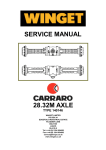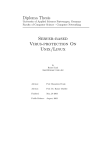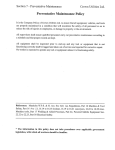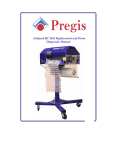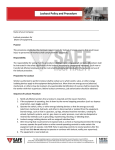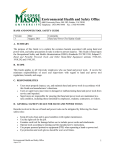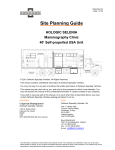Download How to Check the Bescodyne Clutch/Brake Stacks for Wear
Transcript
Service Bulletin To Check the Bescodyne Clutch/Brake Stacks for Wear [1995-1] An easy procedure has been established to visually check the Brake and Clutch stacks to determine whether or not they need to be replaced. Two (2) "Stack Wear" Grooves have been machined in the Input Shaft (#2) Lugs to facilitate this visual check. (See Figure 1) 1. Remove the Inspection Pipe Plug (#14) from the top of the Input Housing. a. CLUTCH STACK WEAR (See Figure 2) 2. Apply air pressure to the Clutch Port. 3. Using a flash light, observe the Clutch Stack through the Inspection Port. If the rear surface of the Clutch Thrust Plate (#5) has moved up to or past the "Stack Wear" Groove #2, the Clutch Stack needs to be replaced. 4. Exhaust the air pressure from the Clutch Port. a. BRAKE STACK WEAR (See Figure 2) 5. Apply air pressure to the Brake Port. 6. Using a flash light observe the Clutch Stack through the Inspection Port. If the rear surface of the Clutch Thrust Place has moved up to or past the "Stack Wear" Groove #1, the Brake Stack is worn and needs to be replaced. IMPORTANT NOTE: Even though both the Brake Stack and the Clutch Stack can individually be checked for wear. If either Stack is worn and needs to be replaced, both Stacks should be replaced as a complete set. Refer to Service Manual and Repair Parts for Clutch/Brake Drives (502- 03/20001) Besser Catalog No. 437629F001, Section 7DISASSEMBLY and Section 9 - REASSEMBLY for Brake and Clutch Stack Replacement. CAUTION: Disconnect and lock-out all Electrical Power to the Drive Motor. This step must be taken to avoid any possibility of personal injury or damage to the Drive Unit 1 SB 1995-1 Rev MR1995 Service Bulletin To Check the Bescodyne Clutch/Brake Stacks for Wear SAFETY BULLETIN [1995-1] This notice is issued to advise you that some previously accepted shop practices may not be keeping up with changing Federal and State Safety and Health Standards. Your current shop practices may not emphasize the need for proper precautions to insure safe operation and use of machines, tools, automatic loaders and allied equipment and/or warn against the use of certain solvents or other cleaning substances that are now considered unsafe or prohibited by law. Since many shop practices may not reflect current safety practice and procedures, particularly with regard to the safe operation of equipment, it is important that you review your practices to ensure compliance with Federal and State Safety and Health Standards. IMPORTANT The operation of any machine or power-operated device can be extremely hazardous unless proper safety precautions are strictly observed. Observe the following safety precautions: ALWAYS: Be sure proper guarding is in place for all pinch, catch, shear, crush, and nip points. Be sure that all personnel are clear of the equipment before starting it. Be sure the equipment is properly grounded. Turn the main electrical panel off and lock it out in accordance with published lockout/tagout procedures prior to making adjustments, repairs, and maintenance. Wear appropriate protective equipment such as safety glasses, safety shoes, hearing protection, and hard hats. Keep chemical and flammable material away from electrical or operating equipment. Maintain a safe work area that is free from slipping and tripping hazards. Be sure appropriate safety devices are used when providing maintenance and repairs to all equipment. 2 SB 1995-1 Rev MR1995 Service Bulletin To Check the Bescodyne Clutch/Brake Stacks for Wear NEVER: [1995-1] Exceed the rated capacity of a machine or tool. Modify machinery in any way without prior written approval of the Besser Engineering Department. Operate equipment unless proper maintenance has been regularly performed. Operate any equipment if unusual or excessive noise or vibration occurs. Operate any equipment while any part of the body is in the proximity of potentially hazardous areas. Use any toxic flammable substance as a solvent cleaner. Allow the operation or repair of equipment by untrained personnel. Climb or stand on equipment when it is in operation. It is important that you review Federal and State Safety and Health Standards on a continual basis. All shop supervisors, maintenance personnel, machine operators, tool operators, and any other person involved in the setup, operation, maintenance, repair or adjustment of Besserbuilt equipment should read and understand this bulletin and Federal and State Safety and Health Standards on which this bulletin is based. 3 SB 1995-1 Rev MR1995



